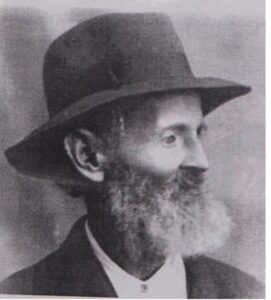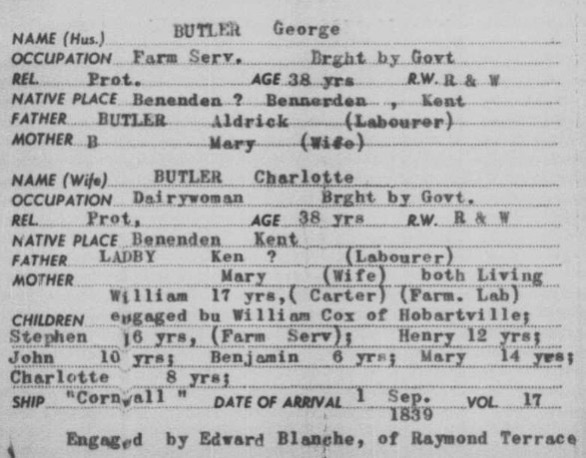The Butlers of Benenden, Kent, England.
Mary Pallet (Pellet), daughter of William and Mary, was baptised in Benenden, Kent, England on 11 March 1769. Alexander Butler and Mary were married on 16 July 1788 in Benenden.[1] I have identified only two children of Alexander and Mary. Alexander Junior was born in 1790 and another son, George was born on 5th October 1800.[2]&[3] George is my GGG Grandfather.
When George was nineteen, he married Charlotte Gladwish on 27 March 1820 at Ticehurst, Sussex. The Minister was Henry Bishop of Ticehurst and witnesses were Henry and Lydia Winsor. Both George and Charlotte signed with an X so must have been unable to write.[4] Ticehurst is about 10 miles from Benenden and I wonder why they chose to marry there rather than at their local Benenden Parish Church. At this stage, I haven’t found a family connection to the minister or the witnesses but perhaps that’s still to be found or maybe, the family objected to the marriage so they eloped.
George and Charlotte Butler had seven children. William was born in 1822 and was baptised on 4 April 1822 at the Parish Church of Benenden in Kent. Stephen appears to have been born in 1823 and Mary in 1824 but they were baptised at the same time on 2 December 1827 at the same Parish Church of Benenden.[5] Henry was born in 1828, John in 1829 and my GG Grandmother, Charlotte in 1832. Benjamin, born 1833 was the last of their children to be born, also in Benenden.

Portrait of Henry Butler
On 12 May 1839, Captain John Cow sailed from Gravesend on The Cornwall, bound for Sydney. The Cornwall arrived on 1 September that year. She had embarked 387 Government-assisted emigrants, 150 men, 94 women, and 143 children under 15 years. She arrived with 374 passengers as 18 infants had died on the voyage and five had been born. The migrants were primarily farm labourers.
George and Charlotte and their seven children were on this ship as Assisted Migrants, arriving in Sydney on 1 September 1839. Their Arrival Card shows that George was a 38 year-old Farm Servant brought by the Government to work for Edward Blanche of Raymond Terrace. Who was Edward Blanche and where was he farming? An Edward Blanche, 26, arrived in Sydney on the Cornwall with the Butlers as an assisted migrant and a Farm Worker. Surely he didn’t own a farm where he could employ George? Edward’s father was also Edward Blanche and he arrived as an assisted migrant on the Maitland in November 1838. He was 50, Baptist and he could read. Raymond Terrace is a town at the meeting of the Hunter and Williams River and it became famous for the production of wine in 1834. So I imagine that Edward Senior headed up to the Hunter when he arrived and acquired a farm for which he needed labourers so he arranged for his son, Edward, and George Butler to come as assisted migrants twelve months later. They were all from Kent – did they know each other before they immigrated? I wonder? Edward Senior died in Raymond Terrace, Tamworth in 1860 so it is possible that he moved north and named Raymond Terrace after the one where he got his start.
The Arrivals Card gives us even more information. George’s wife Charlotte was a 38 year old Protestant who could read and write and was a Dairywoman by profession. Interestingly, both George and Charlotte signed their marriage certificate with a cross but now we have them, 19 years later, both able to read and write. I wonder how they learnt?

NSW Immigration Arrival Card of George Butler and family. Sydney 1 Sept 1839
The card provides information about the children too. William was seventeen and was listed as a Carter and Farm Labourer who was engaged by William Cox of Hobartville. Hobartville Estate is on the Hawkesbury River near Richmond. It was initially a land grant to two men – 100 acres to James Blackman in 1802 and 400 acres to Edward Luttrell in 1804. William Cox Senior, the man who built the first road over the Blue mountains, obtained the Estate at some stage and in 1828 he completed a grand homestead for his son William Cox Junior.
The Estate which is listed on the NSW State Heritage Register still exists as a horse stud and it is being opened to the public on 16 March 2025. Wouldn’t it be lovely to visit this property acquired by the National Trust, to see where William Butler was working in 1839? Stephen was 16 and was listed as a Farm Servant: Mary was 14; Henry was 12; John was 10, Charlotte was 8 and Benjamin, the youngest was 6.
The 1841 census shows that five males and two females were living in their home in Parramatta Road, Petersham which is now almost an inner-city suburb of Sydney, being only six kms from the Central Business District. Two of them are Machinists and the other five are shown as not being listed in the foregoing classes. This means they are not shopkeepers, Mechanics, Shepherds, Gardeners, Stockmen or Domestic Servants. I would think that the five youngest children would be in this category and the parents are the machinists with the two eldest boys living at their workplaces but I’m guessing.
The next time I locate George and Charlotte, they are in Ashfield which is 3 km further west from Petersham in November 1854 for a funeral. Unfortunately, Charlotte has died aged 53 after 34 years of marriage. She was buried in the Cemetery of St John’s Anglican Church in Ashfield, Inner West council, New South Wales.[6]
The 1850s were the beginning of the Australian Gold Rushes and the Butlers were ready to take their chances.
[1]. Kent, England, Church of England Baptisms, Marriages, and Burials, 1538-1914
[2] England, Select Births and Christenings, 1538-1975
[3] Australia and New Zealand, Find A Grave Index, 1800s-Current
[4] East Sussex, England, Church of England Marriages and Banns, 1754-1936
[5] England, Select Births and Christenings, 1538-1975.
[6] Australia and New Zealand, Find A Grave Index, 1800s-Current

Comments
The Butlers of Benenden, Kent, England. — No Comments
HTML tags allowed in your comment: <a href="" title=""> <abbr title=""> <acronym title=""> <b> <blockquote cite=""> <cite> <code> <del datetime=""> <em> <i> <q cite=""> <s> <strike> <strong>